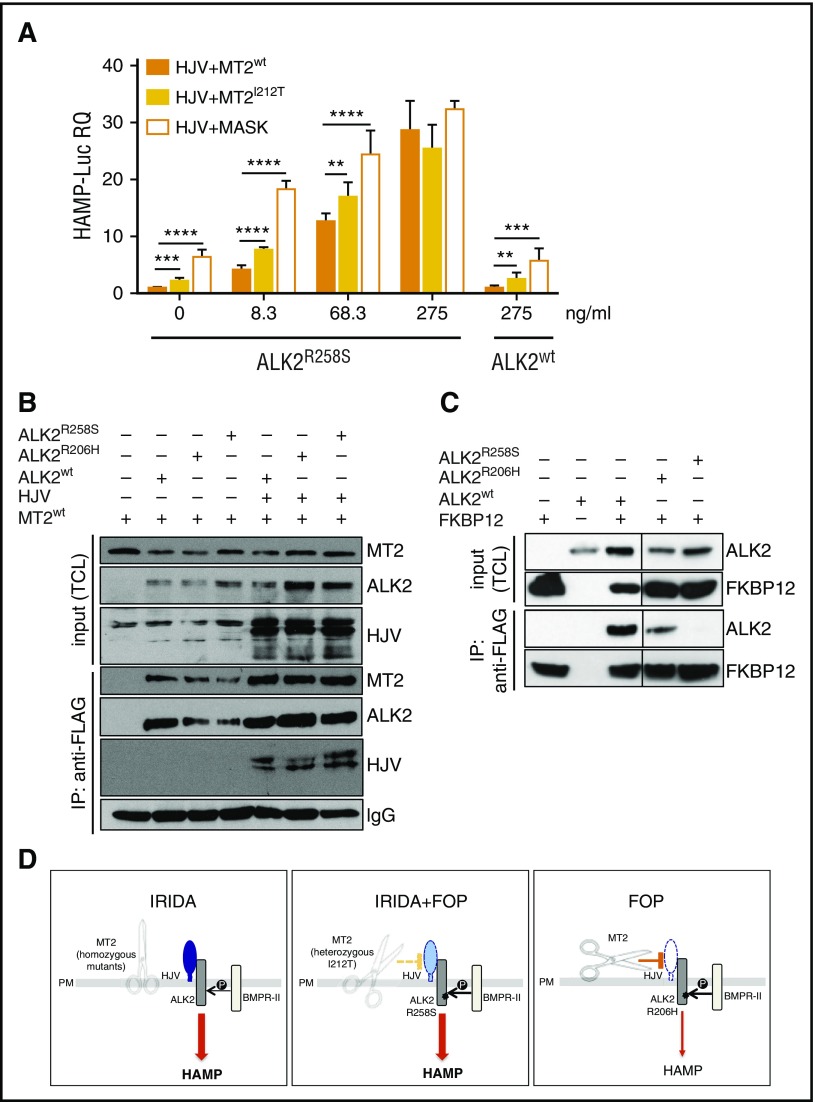Figure 2.
Molecular pathogenesis of the novel form of IRIDA. (A) Hep3B cells were transfected with Hamp-Luc and thymidine kinase promoter–Renilla luciferase reporter plasmid, with fixed concentrations of HJV and MT2wt or MT2I212V and with increasing concentrations (from 8.3-275 ng/mL) of ALK2R258S. As a negative control of MT2 function, we used the inactive protease MT2MASK, the human homolog of the mouse variant that lacks the protease domain4 and does not inhibit hepcidin.5 Cells transfected with the highest (275 ng/mL) concentration of ALK2wt were used as control. Forty-two hours after transfection, cells were lysed, and luciferase activity was measured. The experiments were performed three times in triplicate. A representative experiment is shown. **P < .01; ***P < .001; ****P < .0001. (B) HeLa cells were transfected with MT2HA in the presence or absence of HJV. When indicated, cells were also transfected with ALK2wt-FLAG, ALK2R206H-FLAG, ALK2R258S-FLAG, or empty vector. Forty-two hours after transfection, cells were lysed, and ALK2 was pulled down by using the anti-FLAG M2 affinity gel. Total cell lysates (TCLs) and pull-down proteins were loaded onto a 10% sodium dodecyl sulfate polyacrylamide gel electrophoresis (SDS-PAGE) and processed for Western blot analysis. HJV, MT2, and ALK2 were detected by using the anti-HJV,20 anti-HA, and anti-FLAG antibodies, respectively. Immunoglobulin G (IgG) was used to normalize protein pull down. Arrows indicate proteins recognized by anti-FLAG antibody. IP, immunoprecipitation. (C) HeLa cells were cotransfected with FKBP12MYC-FLAG and ALK2wt-MYC, ALK2R206H-MYC, ALK2R258S-MYC, or empty vector. Forty-two hours after transfection, cells were lysed, and FKBP12 was pulled down by using the anti-FLAG M2 affinity gel. TCLs and pull-down proteins were loaded onto a 12% SDS-PAGE and processed for Western blot analysis. FKBP12 and ALK2 were detected by using the anti-FLAG and anti-MYC antibodies, respectively. Arrows indicate proteins recognized by anti-FLAG antibody. (D) Schematic representation of the TMPRSS6 (MT2) effect on HJV and BMP receptors in the liver. In IRIDA, the inactivation of TMPRSS6 (the scissor) renders the BMP pathway hyperactive because HJV (in blue) is not cleaved from the membrane and acts as a BMP coreceptor; thus, both the signaling pathway and hepcidin expression (thick arrow) are high. In FOP/IRIDA, TMPRSS6 protease is only partially active (dotted yellow line), and some HJV (light blue) remains on cell surface, and together with the constitutively active ALK2, this upregulates hepcidin (thick arrow). In patients with FOP, ALK2R206H is constitutionally active, but the cleavage of HJV (white) by the normal protease (solid orange line) allows hepcidin regulation (thin arrow). HAMP, hepcidin; P, phosphorylation; PM, plasma membrane.

